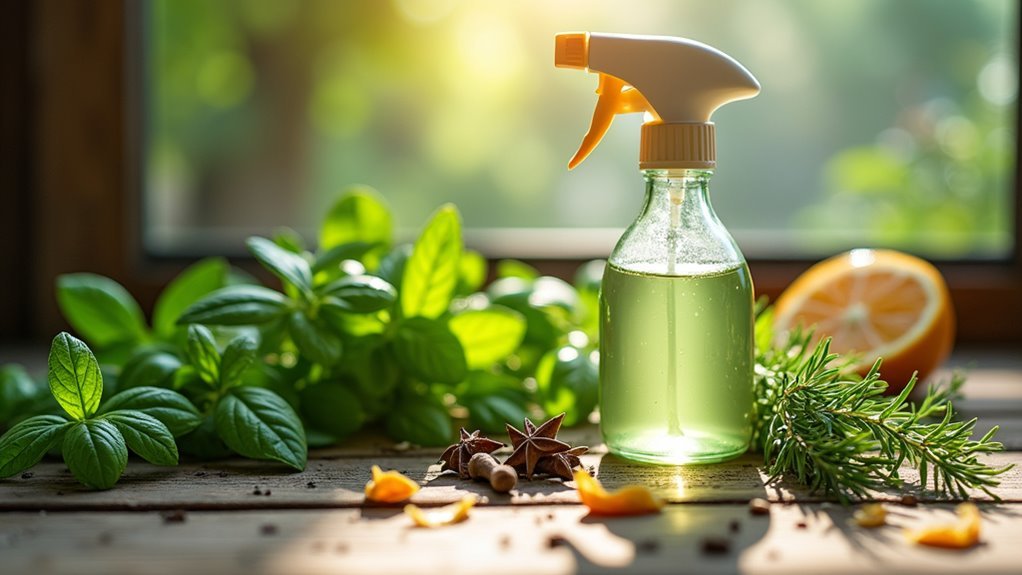You can repel cockroaches naturally using essential oils like peppermint, tea tree, and rosemary mixed with water as sprays. Plant aromatic herbs such as lavender, mint, and catnip around entry points to create effective barriers. Scatter fresh citrus peels or crushed bay leaves in problem areas, and use garlic powder’s pungent scent as a deterrent. These chemical-free solutions freshen your home while disrupting roaches’ ability to locate food sources. Combining multiple plant-based methods will maximize your pest control strategy.
Essential Oils That Naturally Deter Cockroaches

When you’re looking for a natural way to eliminate cockroaches without harsh chemicals, essential oils offer a powerful and aromatic solution.
Peppermint oil, tea tree oil, and eucalyptus effectively repel cockroaches by disrupting their ability to locate food sources through their strong scents.
Rosemary oil proves particularly potent, achieving up to 100% mortality rates at concentrations between 2.5% and 30%.
You’ll find lavender oil works excellently when mixed with water in spray bottles for targeted application.
Catnip oil contains nepetalactone, making it another effective natural repellent that enhances your homemade remedies.
These essential oils don’t just repel cockroaches—they’ll transform your home into a fresh-smelling sanctuary while maintaining your commitment to chemical-free pest control.
Aromatic Plants for Indoor Cockroach Control
While essential oils provide excellent cockroach control, you can maximize your natural pest defense by strategically placing aromatic plants throughout your home.
Plants like lavender, mint, and rosemary emit strong scents that naturally repel cockroaches, serving as effective natural deterrents in indoor spaces. Catnip stands out as particularly powerful due to nepetalactone, a compound that roaches find highly offensive. You’ll want to place catnip sachets in problem areas for maximum impact.
Catnip’s nepetalactone compound makes it exceptionally effective against cockroaches, outperforming traditional aromatic plants like lavender and mint.
For additional protection, grow basil and incorporate cinnamon plants into your décor. These dual-purpose additions enhance aesthetics while deterring pests.
Remember that maintaining plants properly through adequate sunlight and watering enhances their repelling properties, creating a healthier environment that complements your tea tree and eucalyptus essential oils strategy.
Citrus-Based Repellent Solutions

Beyond aromatic plants, citrus fruits offer another powerful weapon in your natural cockroach-fighting arsenal.
These everyday fruits pack strong scents that effectively keep cockroaches away from your living spaces.
Here’s how you can harness citrus power for repelling cockroaches:
- Place fresh citrus peels from oranges and lemons in areas where roaches frequent
- Mix lemon juice with water to create a homemade roach repellent spray that doubles as a surface cleaner
- Use grapefruit juice as a natural deterrent in spray bottles for targeted application
- Dilute citrus essential oils like lemon or orange oil in water for chemical-free pest control
- Replace citrus peels regularly in pantries and cabinets to maintain their repelling effectiveness
These citrus-based solutions provide continuous protection while filling your home with fresh, clean aromas.
Herb and Spice Cockroach Deterrents
You’ll find some of the most effective cockroach deterrents right in your spice rack and herb collection.
Bay leaves create a powerful barrier when crushed and scattered in infested areas, as their strong scent naturally repels roaches and prevents their return.
Garlic and cinnamon work equally well—garlic powder’s pungent aroma acts as a natural deterrent, while freshly ground cinnamon not only repels insects but also prevents cockroaches from climbing treated surfaces.
Bay Leaves Repel Roaches
Bay leaves pack a powerful aromatic punch that cockroaches can’t stand, making them one of nature’s most reliable roach deterrents. This natural repellent offers households with children and pets a completely non-toxic solution that’s both effective and eco-friendly.
Here’s how to use bay leaves as a cockroach deterrent:
- Crush fresh bay leaves and scatter them in roach-prone areas like kitchens and pantries.
- Place whole leaves directly inside cabinets and drawers where roaches hide.
- Focus on areas where you’ve spotted roach activity previously.
- Replace leaves every few weeks to maintain efficacy.
- Combine with other natural methods for enhanced protection.
Bay leaves work as both an immediate repel roaches solution and a long-term preventive measure. Regularly replacing these aromatic leaves guarantees continued effectiveness against unwanted pests.
Garlic and Cinnamon Power
While garlic might ward off vampires in folklore, it’s equally effective at keeping cockroaches away from your home. This powerful bulb contains natural compounds that create a strong odor cockroaches can’t tolerate. Similarly, cinnamon repels roaches by disrupting their navigation abilities with its potent scent.
You can combine these natural repellents into a powerful spray solution by mixing garlic and cinnamon with water. This creates an effective barrier when applied to areas prone to cockroach activity.
| Benefits | Peace of Mind |
|---|---|
| Non-toxic ingredients | Safe around children |
| Pleasant aroma | Eliminates harsh chemicals |
| Food-safe application | Kitchen protection |
| Cost-effective solution | Budget-friendly pest control |
| Long-lasting results | Sustained pest-free environment |
Regular application maintains your pest-free environment naturally.
Plant Extract Spray Recipes

Plant extract sprays offer one of the most versatile and effective approaches to natural roach control, allowing you to harness concentrated essential oils that roaches find repulsive.
These homemade solutions create a natural roach repellent that’s both safe and effective at repelling roaches through their strong scent, keeping roaches at bay without harsh chemicals.
Here are five powerful plant extract spray recipes:
- Mint Oil Spray: Mix 10-15 drops peppermint oil with 2 cups water for targeted application
- Tea Tree Oil Solution: Combine 1 part tea tree oil with 4 parts water for antimicrobial protection
- Rosemary Oil Mixture: Dilute 2 teaspoons rosemary oil in 1 cup water for high pest mortality
- Lavender Spray: Blend 10 drops lavender oil with 1 cup water for pleasant-smelling deterrent
- Cedarwood Oil Spray: Mix 1 teaspoon cedarwood oil with 1 cup water for natural insect-repelling power
Strategic Plant Placement for Maximum Effectiveness
You’ll achieve the best results by positioning your roach-repelling plants in three key zones: indoors near entry points and problem areas, outdoors to create defensive barriers around your home’s perimeter, and in high-traffic areas where roaches commonly travel.
Your indoor placement should focus on kitchens, bathrooms, and entryways where moisture and food sources attract these pests.
Creating an outdoor garden barrier with aromatic plants around windows, doors, and foundation cracks will prevent roaches from reaching your home’s interior in the first place.
Indoor Plant Positioning
Strategic positioning transforms your pest-repelling plants into an effective defense system against roaches. Proper placement maximizes their aromatic properties while creating natural barriers throughout your home.
- Place potted plants like mint and lavender near entry points such as windows and doors to prevent roaches from entering.
- Position rosemary and catnip in kitchen areas where their strong scents interfere with cockroaches’ food-sensing abilities.
- Use hanging pots or wall-mounted planters to maximize vertical space while dispersing aromatic properties effectively.
- Group multiple pest-repelling plants together in high-traffic areas to create more potent deterrent effects.
- Maintain healthy plants with adequate sunlight and regular care to guarantee they repel roaches with ideal scent release.
This strategic approach guarantees your plant-based defense system works efficiently against cockroach infestations.
Outdoor Garden Barriers
Although indoor plant positioning creates effective barriers against roaches, extending your defense system outdoors provides even greater protection by intercepting these pests before they reach your home’s entry points.
Plant mint, lavender, and rosemary around your garden borders to establish natural barriers that deter cockroaches from approaching your residence.
Position catnip near outdoor areas where it’ll repel roaches while attracting beneficial insects to enhance your garden ecosystem.
Place strong-scented plants strategically around doorways and windows to mask food odors that typically attract these pests.
You’ll disrupt cockroaches’ sensory pathways by incorporating multiple cockroach repellents throughout your garden, making it difficult for them to locate food sources.
Regular pruning and ensuring adequate sunlight maintains these plants’ potency as effective natural deterrents.
High-Traffic Area Coverage
When targeting high-traffic areas inside your home, focus your plant placement efforts on locations where cockroaches are most likely to enter and establish themselves.
These zones require strategic coverage to effectively repel roaches before they spread throughout your living space.
Position your plant-based defenses in these critical locations:
- Place mint and peppermint pots near doorways and windows where roaches typically enter
- Position lavender plants in kitchens and dining rooms to create aromatic barriers
- Distribute catnip sachets throughout pantry shelves and food storage cabinets
- Maintain tea tree plants near outdoor entry points for natural oil extraction
- Ascertain all plants receive proper care to maximize their repellent aroma potency
Well-maintained plants in high-traffic areas create overlapping zones of protection, making your home less appealing to unwanted pests.
Creating Natural Barriers With Plant Materials
Since roaches rely heavily on their sense of smell to locate food sources and navigate their territory, you can exploit this vulnerability by establishing natural barriers with aromatic plant materials.
The strong scent from lavender, mint, and rosemary disrupts roaches’ sensory abilities, making these areas less attractive to them.
Scatter crushed bay leaves around baseboards, under appliances, and near entry points where their powerful aroma acts as an effective deterrent.
Place catnip strategically in corners and behind furniture, as its nepetalactone compound naturally repels roaches while remaining pleasant for humans.
Create spray barriers using essential oils like peppermint, tea tree, or eucalyptus diluted in water.
Apply these solutions around doorways, windowsills, and potential hiding spots to maintain consistent protection against cockroach invasions.
Combining Multiple Plant-Based Methods
While individual plant-based remedies can effectively repel roaches, you’ll achieve superior results by combining multiple methods into a thorough defense strategy.
By layering different natural deterrents, you’ll create an environment that’s consistently hostile to these pests.
Here’s how to maximize your plant-based methods for extensive pest control:
- Create an essential oils homemade spray using peppermint, eucalyptus, and tea tree oil for targeted application.
- Scatter crushed bay leaves, catnip, and rosemary around entry points and problem areas.
- Position potted lavender and mint plants indoors for continuous aromatic protection.
- Apply diluted neem oil spray to complement other remedies and disrupt reproductive cycles.
- Place cucumber slices with citrus peels in roach-frequented zones for multi-scented barriers.
This integrated approach guarantees you’ll repel roaches more effectively than single-method applications.
Maintaining Plant-Based Repellent Systems
Once you’ve established your plant-based repellent system, consistent maintenance becomes crucial for long-term success against roaches. Water your repelling plants like lavender and mint regularly while providing adequate sunlight, as healthy plants maintain stronger deterrent properties.
Prune them frequently to encourage growth and enhance their fragrance, which serves as your primary defense mechanism against roaches. Monitor your plants for disease or pest infestations, since unhealthy specimens lose their repelling effectiveness.
Integrate diverse varieties like catnip and rosemary throughout indoor and outdoor spaces for thorough coverage. Extract essential oils from your thriving plants to create homemade sprays that boost your system’s potency.
This multi-layered approach guarantees your natural repellent remains powerful and sustainable over time.
Frequently Asked Questions
What Is the Best Homemade Roach Repellent?
You’ll find peppermint oil mixed with water creates the most effective homemade roach repellent. Spray this solution around entry points and surfaces where you’ve seen roaches, as they can’t tolerate the strong scent.
What Plant Repels Cockroaches?
You’ll find lavender works exceptionally well at repelling cockroaches. Its strong aroma deters these pests effectively. You can also use mint, rosemary, catnip, or tea tree plants for natural roach control.
What Home Remedy Keeps Roaches Away?
You can spray diluted essential oils like peppermint around your home, scatter crushed bay leaves in cabinets, or use garlic and onion sprays to effectively repel cockroaches naturally.
What Smell Keeps Roaches Away Naturally?
You’ll find citrus scents from lemons and oranges naturally repel roaches. Peppermint, tea tree, and eucalyptus essential oils work effectively too. Bay leaves, catnip, garlic, and cinnamon also create strong aromas that keep these pests away.
In Summary
You’ve now got a complete arsenal of plant-based weapons against cockroaches. Don’t rely on just one method—combine essential oils, citrus peels, and aromatic herbs for maximum impact. You’ll need to refresh these natural barriers regularly and place them strategically around entry points. Stay consistent with your plant-based approach, and you’ll create an environment that roaches simply can’t tolerate without using harsh chemicals.





Leave a Reply